#leptoceratopsidae
Text
Dinosaur with most grotesquely deep jaw proportion to its own head (not mention a huge head compared to rest body)
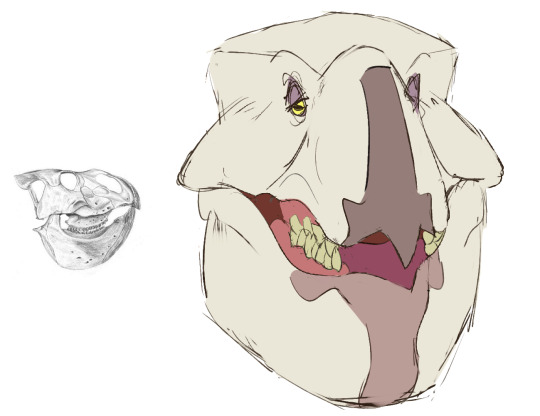

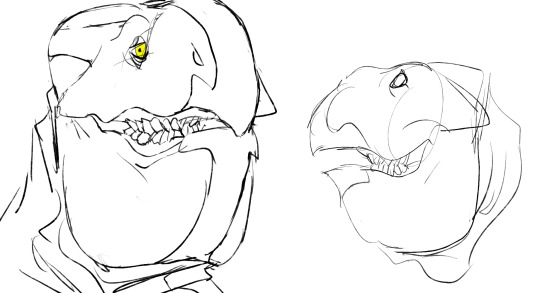

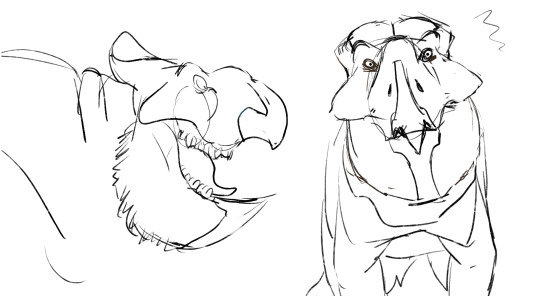
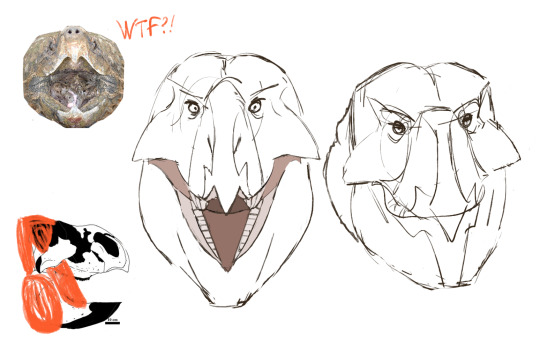
Only after a while I realized that barrel ones look like snapping turtles (Chelydridae). Very shape dudes, and they aren't related to Protoceratops.
#udanoceratops#leptoceratopsidae#ceratopsian#cretaceous#paleoart#prehistoric#paleontology#cartoon#gigachad
1K notes
·
View notes
Text

Day 27: Udanoceratops tschizhovi
#paleoart#art#dinosaur#prehistoric#paleontology#digitalart#traditionalart#Archosaur#Archovember2023#Archovember#Dinovember#Dinovember2023#DrawDinovember#DrawDinovember2023#Udanoceratops#Udanoceratopstschizhovi#Leptoceratopsidae#Ceratopsia#paleoblr#palaeoblr#digital art
40 notes
·
View notes
Text
Udanoceratops tschizhovi. Not sure if I like or dislike this drawing.

16 notes
·
View notes
Photo

Day 28: Udanoceratops tschizhovi. Another, but yet largest known leptoceratopsidae of the Djadochta formation. #DjadochtaJuly #paleoart #sketches #artistsoninstagram #myart #sketch #sketchbook #udanoceratops #udanoceratopstschizhovi #leptoceratopsidae #ceratopsia #marginocephalia #ornithischia #dinosauria #dinosaurs https://www.instagram.com/p/CgjEmNPuaeO/?igshid=NGJjMDIxMWI=
#djadochtajuly#paleoart#sketches#artistsoninstagram#myart#sketch#sketchbook#udanoceratops#udanoceratopstschizhovi#leptoceratopsidae#ceratopsia#marginocephalia#ornithischia#dinosauria#dinosaurs
0 notes
Link
*deep breath* Yeah this is inaccurate let me list all of them out.
1. This thing is implied to be a ceratopsian which all of them are herbivores, which they should have eyes like that of a goat’s eyes horizontally slit than vertically slit like what you’d see on a predator like a cat or a snake
2. Its feet should look more dinosaur-like rather than elephantine.
3. The front limbs should be sprawling but I’ll excuse it because it is hard to give a 2D drawing a sprawling position unless it’s from the front.
4. The legs are too short but the body and tail proportions are correct for a ceratopsian ironically.
5. Too many spikes on it’s tail I’ll accept it if those are more rather made out of keratin which I am surprised that none of the carnivores in it’s local environment haven’t gone extinct yet...
I hope this taught yall something and btw if I remember correctly this is my first post
#ceratopsian#ornithischia#dinosaur#dinosauria#inaccuracies#kosmoceratops#awesomebro#scientific inaccuracies#ceratopsidae?#marginocephalia#leptoceratopsidae?
1 note
·
View note
Text
also I'm sorry for forgetting elasmarians in ornithopods I promise to include them in the misc one
#dinosaurs#palaeoblr#prehistoric life#polls#marginocephalians#ceratopsians#pachycephalosaurs#triceratops#styracosaurus#protoceratops#psittacosaurus#pachycephalosaurus#et al
193 notes
·
View notes
Text
Leatherback horses are actually basal rhinos that evolved before horses were introduced to the Iberian continent, but they got along well with their smaller cousins, living in mixed herds protected by stallions weighing over two tons capable of manipulating the wind
Due to evolution on a prairie full of predators, they have developed remarkably thick skin, mostly on the throat, using their breezes to dissipate heat, have a small protohorn, are capable of being tamed like heavy cavalry
They share their habitat with the huge giraffidae Dorukhans, whose bulls have killed several stallions foolish enough to try to face them and are hunted by the feared banderosa drakes, shadowy pack hunters Leptoceratopsidae
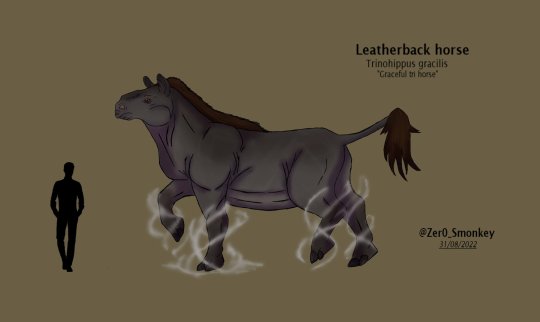


3 notes
·
View notes
Photo
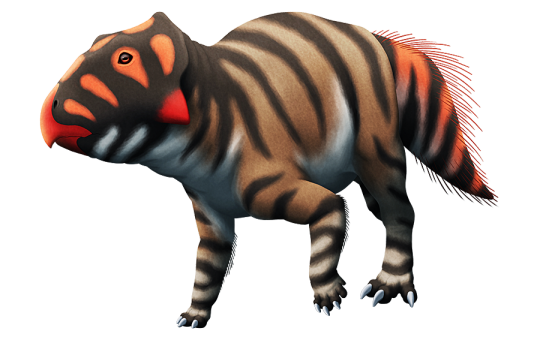
Although much less famous than their larger horned and frilled relatives, the leptoceratopsids were a widespread and successful group of ceratopsian dinosaurs during the Late Cretaceous, with fossils known from North America, Asia, and Europe (and, dubiously, Australia).
They were fairly small stocky quadrupedal dinosaurs, sort of pig-like, with short deep jaws and powerful beaks adapted for eating fibrous low-level plants like ferns and cycads — and to process such tough food they even evolved a chewing style similar to mammals like rodents.
Prenoceratops pieganensis here is known from the Two Medicine Formation bone beds in Montana, USA, dating to about 74 million years ago. Around 1.5-2m long (~5'-6'6"), it was very similar to its later relative Leptoceratops, but had a slightly lower, more sloping shape to its skull.
———
Nix Illustration | Tumblr | Pillowfort | Twitter | Patreon
#science illustration#paleontology#paleoart#palaeoblr#prenoceratops#leptoceratopsidae#neoceratopsia#ceratopsian#marginocephalia#neornithischia#ornithischia#dinosaur#art#pigrodent dinos
279 notes
·
View notes
Photo

[Heads #2] Udanoceratops
Family - Leptoceratopsidae
#Leptoceratopsidae#Udanoceratops#Ornithischia#Dinosauria#Cretaceous#art#paleoart#digitalart#digitaldrawing#procreatart#speculation#restoration#reconstruction#head#headdrawing#ceratopsian
7 notes
·
View notes
Photo
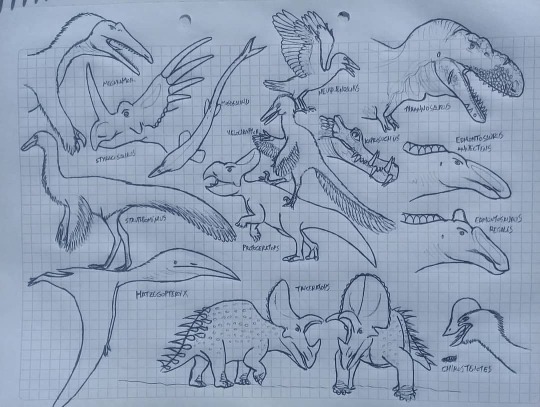
Here are some quick mesozoic tetrapods sketches. #tyrannosaurus #tyrannosauridae #tyrannosaurusrex #edmontosaurus #hadrosaururine #duckbilleddinosaur #chirostenotes #oviraptorid #triceratops #chasmosaurinae #ceratopsian #protoceratops #leptoceratopsidae #velociraptor #velociraptorinae #dromaeosauridae #kaprosuchus #notosuchia #neuquenornis #enantiornithine #mosasauridae #styracosaurus #centrosaurinae #tetanurae #megaraptor #struthiomimus #ornithomimid #hatzegopteryx #azdarchid https://www.instagram.com/p/B61PNdpFbRM/?igshid=vdo0kvtdvkjl
#tyrannosaurus#tyrannosauridae#tyrannosaurusrex#edmontosaurus#hadrosaururine#duckbilleddinosaur#chirostenotes#oviraptorid#triceratops#chasmosaurinae#ceratopsian#protoceratops#leptoceratopsidae#velociraptor#velociraptorinae#dromaeosauridae#kaprosuchus#notosuchia#neuquenornis#enantiornithine#mosasauridae#styracosaurus#centrosaurinae#tetanurae#megaraptor#struthiomimus#ornithomimid#hatzegopteryx#azdarchid
0 notes
Text
Holocene Dinosaurs - Ludoceratopsidea Part 1
Large ceratopsid dinosaurs like Triceratops gradually disappeared in the late Cretaceous, but some of their representatives survived into the early Paleocene.
However, their smaller relatives in Asia and North America, the Leptoceratopsidae dinosaurs, appeared in the Late Cretaceous. In the closed forests of the Palaeocene, these dinosaurs evolved into cavity-dwelling omnivores. The vast forests became increasingly sparse. The undergrowth gained more light and became more richest, providing food for smaller herbivores. The Leptoceratopsidae dinosaurs grew in size over millions of years. By the end of the Eocene, the first Ludoceratopsidae dinosaurs appeared.
They spread across the ever-expanding plains of Asia to North America and the savannas of Africa in the Miocene.
Ludoceratops savannicus

When the African continent joined Eurasia in the Miocene period, it also closed the Mediterranean basin. The hitherto isolated region opened the way for many Eurasian animal groups. Like the Ludoceratops.
These dinosaurs had numerous advantages over the native herbivores Sauropoda and Iguanodontidea.
Primarily, they had a more efficient chewing ability and a more complex digestive system. This allowed them to extract more nutrients from the tough leaves of the increasingly proliferating grasses. As the savannah slowly became the dominant terrain in Africa, the legs of Ludoceratops became longer to allow them to roam the landscape more in search of food.
As the climate of the African continents is much drier and rainfall is seasonal, these herbivores have to migrate. The young grow much faster to keep up with the huge herds.
Ludoceratops sylvestris

The smallest species of ludoceratops. It lives in small family groups in temperate forests of Eurasia.
They are generally found around nesting sites. They migrate only when they migrate from nearby watering places.
Ludoceratops sibiricus

Common herbivores of northern tundra and pine forests. They are protected from the cold of the Arctic by a thick layer of feathers and fat.
In the long winters they dig lichens and mosses out of the snow with their hooves, but in the short summer they pick up the fat by grazing continuously
After hatching, the chicks stay with the flock until the beginning of summer
They move in the middle of the flock.
#speculative evolution#animals#wildlife#dinosaurs#dinosaur#speculative zoology#speculative biology#alternative history
7 notes
·
View notes
Text
Various Udanoceratops

I started drawing 'em on October 30. I had to draw something Halloween, and found this dinosaur. This early ceratopsian is a giant leptoceratopsid. Its large jaws fragments strikes imagination - skull looks like Jack O Lantern in flesh
These folks are striped with bright heads because they're huge and conspicuous. The feather coat from sparse bristles has been transformed into a mane along the spine because it looks much more authentic and even realistic. The rest of shagginess - on jaw and paws - is the transition form between the scales and (proto)feather. Many have a lower beak down the chin - this depicted not only in reconstructions, but I also noticed it in fossils of P. hellenikorhinus. It plays role of a lips and even beard (just like upper), and having a light color adds volume and old age at the same time.
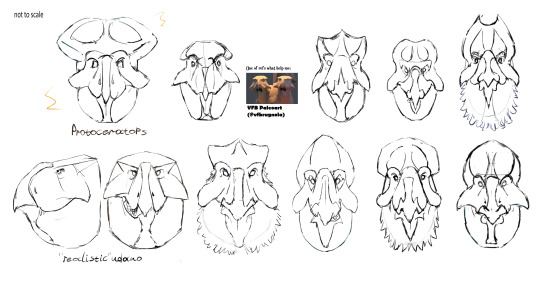
For experiment i drew em in frontal. There is no picture/diagram on Internet where fossils can be viewed from other angles except profile. Anyway, I gave everyone binocular vision, because that’s basic thing for (small) Neoceratopsia. I use some 3D references and Protoceratops anatomy.
I drew these Udanoceratops earlier, and here they have slight frills that aren't wider than jugal/zygomatic/cheek horns.
114 notes
·
View notes
Photo



Microceratus (Microceratops until 2008)
Scientific Name: Microceratus Gobiensis
Dimensions: 60 cm-1 m long, and 45 cm tall
Lived: Cretaceous Period
Geographical Range: Mongolia, Asia
Liked: Scratching its frill since he was probably bipedal unlike his bigger
cousins
Disliked: Itchiness behind its frill
Taxonomy:
Animalia>Cordata>Dinosauria>Ornithischia>Ceratopsia>Neoceratopsia>Leptoceratopsidae>Microcerauts>Gobiensis
Microceratus is the smallest dinosaur, at least discovered up to date, to belong to the same family as the Triceratops, the Ceratopsians. It is also the smallest dinosaur to appear in Jurassic World. The name Microceratus means “small horned”. This small (2-3ft long) horned dinosaur lived 90 mya in the Cretaceous period in what is today the Gobi desert of Mongolia, eating low branches from trees or plants with the help of its sharp beaked mouth.
The first fossils of this toy sized Ceratopsian were discovered in the late 20’s and early 30’ by a Sino-Swedish expedition, mainly teeth, parts of the jaw and fragments of the skeleton. In 1953, the remains were named Microceratops (meaning “small horned face”). It wasn’t until 2008 that scientists realized Microceratops was already in use for a genus of wasp, and its named was changed by Octavio Mateus to Microceratus.
Because of its small size many scientists believe that Microceratus was likely a bipedal dinosaur, to be more agile and faster, an important adaptation to run away from potential predators since its frill was likely just for display and not big or thick enough for proper defense.
Bonus: Microceratus means small horned, yet this animal didn’t have any.
-BLEB-
Photo Credit: http://bit.ly/1KgE9Mx
http://bit.ly/1KLOSfU
https://jurassicpark.fandom.com/wiki/Microceratus?file=Microherd.png
Sources: http://bit.ly/1FEK0on
http://bit.ly/1BRhrDC
60 notes
·
View notes
Note
Why is it that most ceratopsian families (ex. Leptoceratopsidae) are spelled as "-psidae", but for Bagaceratopidae it's "-pidae"?
I’m pretty sure it should grammatically be “-topidae”, and the others just messed it up and it stuck.
24 notes
·
View notes
Text
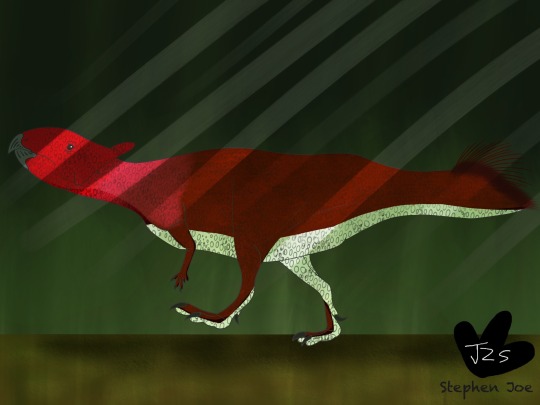
Day 22: Cerasinops hodgskissi
A cherry-faced leptoceratopsidae is possibly a small bodied ceratopsian that lived in what is now called Montana.
#my art#dinosaur#dinosaurs#paleoart#dinosauria#ornithoscelida#ornithischia#genasauria#neornithischia#cerapoda#marginocephalia#ceratopsia#neoceratopsia#coronosauria#leptoceratopsidae#cerasinops#draw dinovember#dinovember#procreate#procreate5x#artists on tumblr
3 notes
·
View notes
